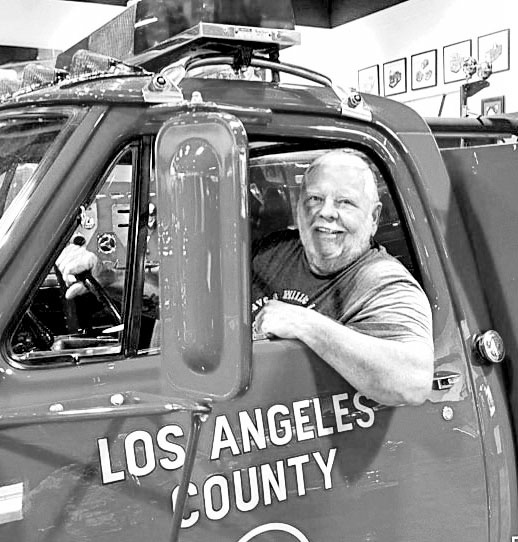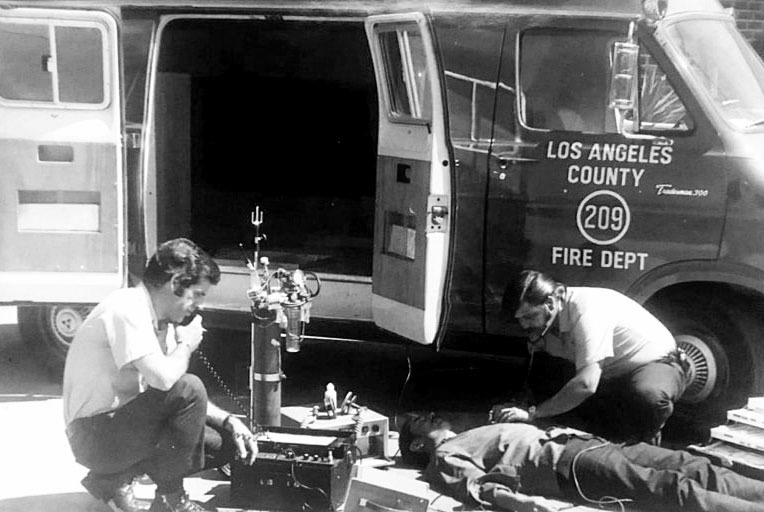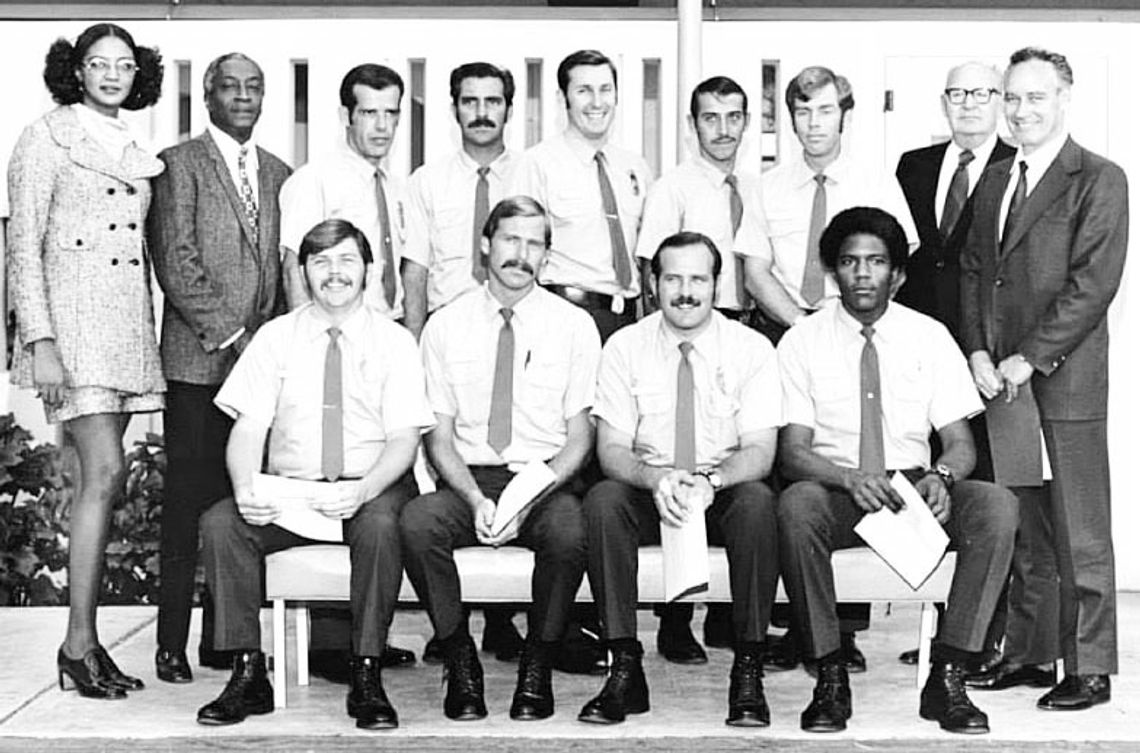Long before “Emergency!” brought flashing lights and sirens to America’s living rooms, Robert“Bob”McCulloughwas living the real thing.
NowretiredinthequietHill Country town of Medina, Mc-Cullough was among the first generation of firefighter-paramedics with the Los Angeles County Fire Department — a groundbreaking role in emergency medical services at a time when the entire concept of pre-hospital care was still in its infancy.
“Back then, we were making itupaswewentalong,”said McCullough,nowasoft-spoken man with a gentle demeanor. “But we knew we were onto somethingthatcouldsavelives.”
What most people now take for granted — that calling 911 brings trained professionals capable of delivering life-saving care before the hospital — was oncearadicalidea.Anditwasn’t untilHollywoodtooknoticethat themovementfounditsnational spotlight.
That happened on Jan. 15, 1972, with the debut of Emergency!, adramaseriesproduced by Dragnet star Jack Webb in close collaboration with the L.A. County Fire Department. The series dramatized real calls pulled from LACFD’s archives and featured characters modeled after actual firefighters and paramedics — including McCulloughandhiscolleagues.
It would go on to run for six seasons, popularize the term “paramedic,”and,aslegalscholar PaulBergmanlaterarguedin theBaltimoreLawReview,help fueltherapidexpansionofEMS programsacrossthecountry.
But for McCullough, who joined the fire service fresh off a U.S. Navy tour during the Vietnam War,theroadtobecoming oneofCalifornia’sfirstparamedics was anything but scripted.
From Navy Ship to Fire Station McCullough served aboard the USS Ashtabula, a fleet oiler, from1964to1967.Ashisenlistment drew to a close, a conversation with his father — a fire captain in Santa Monica — set himonanewpath.
“He said, ‘What about the firedepartment?’”McCullough recalled. While the Ashtabula was in dry dock, his father filed afiredepartmentapplicationon his behalf.
Soon after, McCullough learned he was one of just 10 candidates selected from over 2,000 applicants for the Los AngelesCountyFireAcademy. Hewasstillonactivedutywhen the acceptance came through, but his Navy captain, Ralph Graham, granted him an early dischargewithonesimplecomment: “I’m happy to support any public service.”
Within days, McCullough began fire training at the academy. He graduated and was assigned toStation69inTopanga, underthecommandofCaptain James O. Page — who would later become known as the “father ofEMSinLosAngeles.”
ItwasPagewhoencouraged McCulloughtojointhecounty’s new paramedic program. The turning point came during the 1971Sylmarearthquake,which collapsed the Los Angeles VA Hospital and killed dozens. McCullough helped with the responseandwasdeeplyaffected by the calm professionalism of the new paramedics at the scene.
“Isawhowtheymoved,how they treated people with such care,”hesaid.“Itwassomething Iwantedtobepartof.”
Baptism by Fire
McCullough became the 38th graduate of the Los Angeles County paramedic training program, which had been shaped in part by battlefield medicine developed during the Vietnam War. By 1971, he was assigned to Fire Station 9 in Watts — a community still reeling from the 1965 riots and plagued by deep distrust of authority.
It was, he said, a true trial by fire.
On average, a typical L.A. County paramedic unit might handle 10 to 15 calls per 24hour shift. At Station 9, Mc-Cullough and his partner Ed McFall — a Watts native — were seeing 40 to 50.
“You just never knew what kind of call you’d get,” he said. “Accidents, shootings, assaults. You had to be calm and adapt fast.”
He recalled how residents, used to the old “scoop and run” ambulance style, would sometimes pull guns or knives on paramedics who stayed too long at the scene trying to stabilize patients.
“I learned to start an IV right in front of the family, to show them I was helping,” McCullough said. “I’d repeat over and over, ‘I’m here to help.’ That usually worked.”
McCullough served 17 years as a paramedic, later specializing in wildfire response in the Malibu area. After retiring from the LACFD in 1986, he continued to serve in various roles, including as a paid dispatcher and a volunteer with rural fire departments.
A Legacy Onscreen
It was McCullough’s early workthathelpedshapethelook and feel of Emergency!. Jack Webbinsistedonrealism,using realmedicalcases,firegear,and evenactualLACFDdispatches to ground the show in authenticity. Webb toured stations and spoke to paramedics — including McCullough — to better understand the work.
So committed was Webb to authenticity that he had the LACFD issue real badges to the show’s stars. The characters of Johnny Gage and Roy DeSoto, played by Randolph Mantooth and Kevin Tighe, were modeled directly on paramedics like McCullough.
Although Emergency! never won major awards, it left a lastingimprint.Whentheshow beganairingin1972,onlyadozen paramedicprogramsexisted nationwide. Within three years, 46 states passed laws enabling paramedics to operate and standardized their training. By 1975, over 2,000 paramedics werecertifiedintheU.S.Today, that number exceeds 142,000, with similar certifications held byhundredsofthousandsmore worldwide.
“I never thought of myself as a pioneer,” McCullough said, shrugging off the title. “We just wanted to help people.”
But when he watches Emergency! reruns now — sometimes late at night, flipping through cable channels — he sees more than just old uniforms and TV drama. He sees a turning point in American public service. He sees himself.
And he hopes others still feel inspired.
“We wanted people to know what was possible,” he said. “That you could help right there, on the sidewalk, before the hospital. And that it could make all the difference.”

Medina resident and retired Los Angeles County firefighter-paramedic Robert “Bob” Mc-Cullough sits in Squad 51, the vehicle used in the filming of Emergency! COURTESY PHOTO

A publicity photo from the Los Angeles Times shows a Los Angeles County Fire Department rescue vehicle and personnel. Medina resident Bob McCullough is pictured at right. COURTESY PHOTO






.png)
